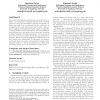Free Online Productivity Tools
i2Speak
i2Symbol
i2OCR
iTex2Img
iWeb2Print
iWeb2Shot
i2Type
iPdf2Split
iPdf2Merge
i2Bopomofo
i2Arabic
i2Style
i2Image
i2PDF
iLatex2Rtf
Sci2ools
ATAL
2005
Springer
2005
Springer
Catch me if you can: exploring lying agents in social settings
Embodied conversational agents become more and more realistic concerning their conversational and their nonverbal behaviors. But if the information conveyed nonverbally exhibits clues that are not consistent with the verbal part of an agent’s action, how will the user react to such a discrepancy? Masking ones real emotions with a smile is a naturally occuring example of such a discrepancy. But such masks are often deficient and thus subtle clues of lying and deceiving manifest themselves in facial expressions. The questions is how users will react to these clues if they are conveyed by an agent. Will they render an application unattractive or on the contrary more human-like? In this paper, we examine such facial clues to deception and present the results of two empirical studies: i.) lies in monologues by a talking head presenting movies, ii.) lies in an interactive game of dice. Categories and Subject Descriptors H.5.1 [Multimedia Information Systems]: Artificial, augmented, and ...
| Added | 26 Jun 2010 |
| Updated | 26 Jun 2010 |
| Type | Conference |
| Year | 2005 |
| Where | ATAL |
| Authors | Matthias Rehm, Elisabeth André |
Comments (0)

